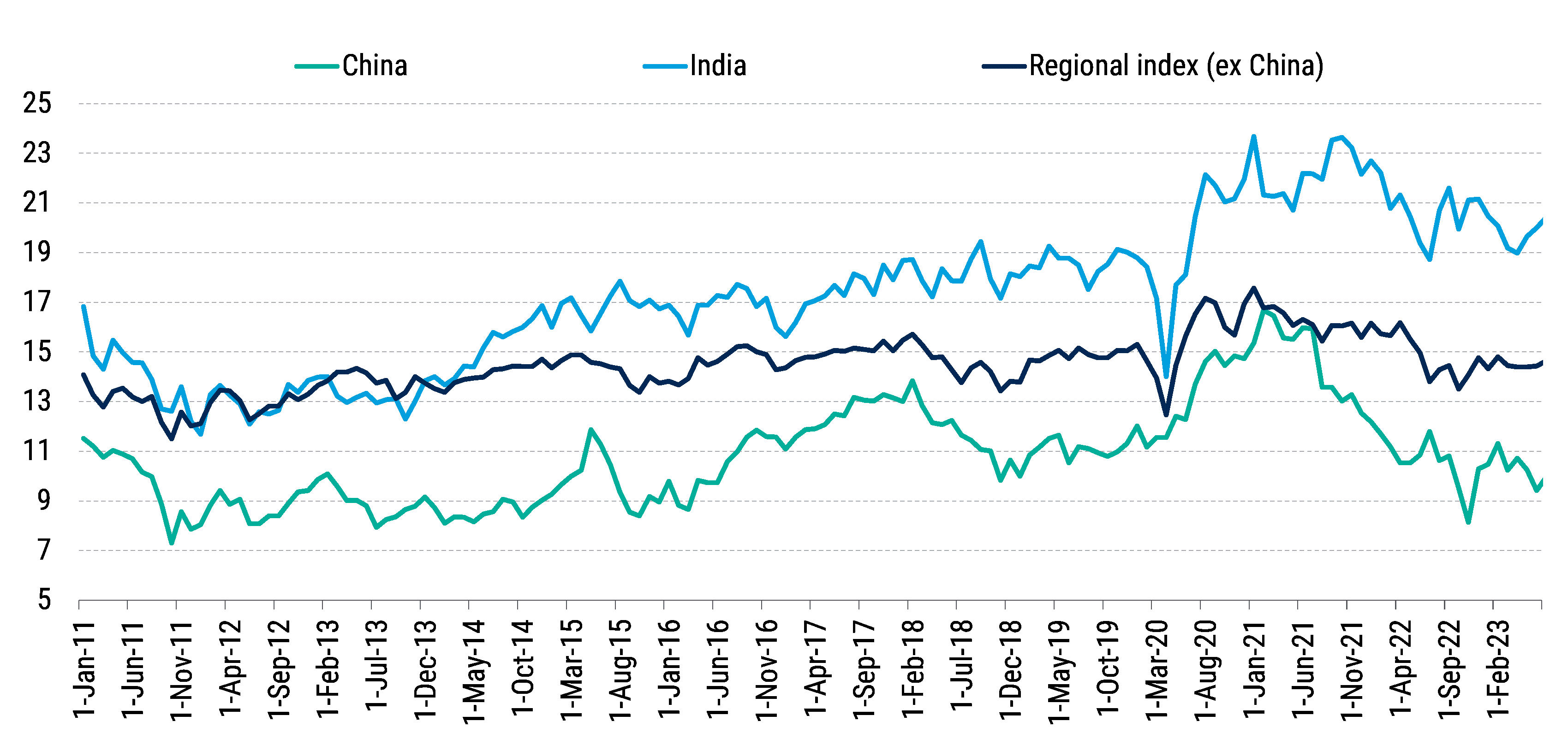Select your geography
Americas
2024 Asia ex Japan Equities Outlook: Back to Basics

Elizabeth Soon, CFA
Head of Asia ex-Japan Equities

Cynthia Chen, CFA
Portfolio Manager, Asia ex Japan Equities

Priyasha Mohanty
Equity Product Specialist
Asia’s continued strong growth momentum and relatively promising outlook should provide attractive potential for selective equity investors in 2024.
Disruptive technological innovation is a key theme within which investors can expect to find rewarding and untapped opportunities in those companies well-placed to benefit from the transformations underway. Small-cap names should be especially appealing.
Asia’s two biggest economies cannot be overlooked. While China requires a patient, company-specific investment focus as the economy gradually stabilizes, India is surging ahead across multiple sectors – assuming investors keep an eye on heady valuations.

Most investors will likely be thankful to see the end of 2023 as far as equity markets go.
It has been a year defined by relentless turbulence and disruption to the global economy. And in combination with the higher-for-longer interest rate regime that looks set to linger in developed markets until well into 2024, many investors realize the only way to find consistent alpha is to go back to basics: well-researched, bottom-up analysis targeting individual markets and sectors with businesses that have robust financials and competitive advantages.
Asian markets could be fertile hunting ground. This optimism is supported by the International Monetary Fund’s (IMF’s) latest outlook for Asia-Pacific, which maintains that it continues to be and will remain a key driver of global growth in 2023 and 2024.
Despite headwinds from changing global consumer demand and tighter monetary policies, Asia-Pacific is expected to grow by 4.6% in 2023, up from 3.9% in 2022 – although growth is projected to slow to 4.2% in 2024.1 Yet this still outpaces the global economy, which the IMF said is “limping along” with a baseline forecast that growth will slow to 3% this year and 2.9% next, well below historical averages.
With this in mind, we see the likelihood of higher GDP growth for the Asia ex Japan region as translating into corporate earnings and revenues.
Key Convictions
1. Focus on the key trend of disruptive innovation.
Perhaps the most notable of several emerging and evolving themes across the region that should be compelling for stock buyers is the disruptive technological innovation stemming from Asia’s structural growth story.
From automation and digitalization, to electric vehicles (EVs) and the manufacturing of capacitors, to the newest trends, such as generative artificial intelligence (AI) and healthcare innovation – all of these are likely to create appealing sources of alpha in the long run.
We believe investors can find rewarding and relatively untapped opportunities in companies well-placed to benefit from these trends, especially given their nascent stages of development. As always, the caveat is to look beyond fads and find companies that exhibit quality characteristics to enable them to sustain growth in the long-term.
Tech-led transformation will also benefit key markets within ASEAN, which has the potential to become the next investment destination of choice for global investors looking to diversify supply chain risks.
Here, growth is decent, and valuations are reasonable. The OECD forecasts ASEAN’s average real GDP growth to reach 4.6% in 2023 and 4.8% in 2024.2 Further, foreign direct investment inflows have been catching up with China in the past few years. For example, Vietnam and Malaysia are thriving on the back of electronics manufacturing, while Indonesia is emerging as a strong player in related battery production for EVs.
Traditional tech-heavy markets Taiwan and Korea should also capitalize on the tech wave. Taiwan undoubtedly dominates the market for outsourced semiconductor manufacturing, accounting for up to 60% of global foundry revenue in 2020.3 This has led to foreign buyers being upbeat about Taiwan’s manufacturing capabilities and investment environment. At the same time, growth should be robust in the short- to medium-term amid AI-related demand.
Meanwhile, Korea is also likely to gain from AI’s far-reaching potential. As a front-runner in the semiconductor industry, stable cash flows and higher dividend payouts from market leaders point toward investment opportunities from the combination of stable income and growth potential.
2. Look toward the small-cap space.
We also believe investors should not miss out on attractive names in Asia’s small- and mid-cap universe.
It remains highly under-researched yet allows investors to tap into long-term fundamental trends buoyed by disruptive technological forces in fast-growing and dynamic markets, from AI to semiconductors to space automation. More specifically, there are over 3,000 small- and mid-cap companies, offering a buffet of dedicated niche themes which complement large-cap leaders.
Particularly for small-cap names, growth is often much bigger and faster given a lower base and exposure to structural themes at a nascent stage that have more potential to benefit from a steeper trajectory of growth. In addition, small-cap firms tend to direct their revenue streams toward domestic growth, which guards them to some extent from the direct impact of any geopolitical uncertainties or external setbacks.
Investing in small- and mid-cap companies also creates the desired diversification for investors within specific segments, rather than the blanket approach that is more common among large-cap businesses.
3. Be patient in China to get rewarded.
Our outlook for China is more measured than in previous years, as the market still awaits a consistent post-pandemic macroeconomic recovery. In line with this, we expect 2024 to be a year of stabilizing and modest recovery in response to disappointments in 2023.
We foresee a supportive yet disciplined policy roll-out from fiscal, monetary, and industrial perspectives.
Given the low levels today of foreign investment in China from an equity market perspective, any incremental good news could help to narrow an underweight position or trigger an increase in exposure to China equities. Combined with domestic valuations being low relative to their historical range and also to regional peers, this creates a good backdrop for equity investors.
While various factors could still delay China’s economic recovery, such as trade-related issues and likely volatility, the widening valuation gap between China and other Asian equity markets should present attractive investment opportunities in the medium term.
To seize these opportunities, we believe it is necessary to continue to take a bottom-up and company-specific investment focus. This applies to tourism, for instance, which is likely to rebound once flight schedules normalize; and with recent macro data showing signs of stability in manufacturing order intakes, this bodes well for industrial companies.
Valuation Gap Between China and Regional Index Continues to Expand
Index Forward PE Valuation Comparison (x)

Source: PineBridge Investments and Bloomberg data as of 30 September 2023. For illustrative purposes only. All investments involve risk, including possible risk of principal. Any views represent the opinion of the investment manager, are valid only as of the date indicated, and are subject to change.
4. India remains appealing as growth surges.
India is supported by strong economic growth momentum, robust corporate earnings, broad-based recovery in sectors from financials to autos to fast-moving consumer goods, local credit growth, and sound monetary policy.
Further, the country is well-placed to benefit from the trend to reshape supply chains. With an increasing number of US and European companies accelerating “friend-shoring” and near-shoring, India is one of the more attractive manufacturing locations.
These dynamics helped justify the IMF’s recent upward adjustment to its India GDP projection by 0.2%, to 6.3% for both this year and next.4
The financial sector is an important pillar for India’s growth and stability. The asset quality of domestic banks has improved, thanks to falling non-performing loans, in turn contributing to robust balance sheets. A higher proportion of personal loans have also driven credit expansion in recent years. Further, exports of services are performing well, with growth in technology service exports continuing unabated while business services exports have picked up since the pandemic.
What’s also encouraging is that previous constraints, such as capital and energy, are much less of a concern today – given the banking sector’s expansion and resilience, along with significant investment in new energy sources such as renewables.
However, investors must also be wary of certain risks, such as high valuations of many small- and mid-cap companies, from a rally that is unlikely to be sustainable over time.
Yet there is still more scope for growth in India. The MSCI EM Index underrepresents the country, plus compelling valuations in large caps and key sectors create the potential for global investors to boost Indian allocations within their equity portfolios.
Quality continues to count
We believe the focus across Asia in 2024 should continue to be finding quality, mispriced opportunities – but doing so before the trends emerge.
Amid so much competition for alpha in a region so dynamic and fast-growing, doing this consistently relies on being able to gain awareness of on-the-ground developments within the key markets and sectors where we see the biggest potential over the next 12 months.
As always, the key is to find quality companies with scalable and sustainable business models, guided by efficient leadership and that have the potential to grow.
For more investing insights, access our 2024 Global Investment Outlook.
1Source: IMF, October 2023 Regional Economic Outlook for Asia and Pacific. https://www.imf.org/en/Publications/REO/APAC/Issues/2023/09/27/regional-economic-outlook-for-asia-and-pacific-october-2023 2Source: OECD, Economic Outlook for Southeast Asia, China and India 2023. https://www.oecd.org/dev/asia-pacific/economic-outlook/Overview-Economic-Outlook-Southeast-Asia-China-India.pdf 3Source: Trendforce. https://www.trendforce.com/presscenter/news/20220425-11204.html 4Source: IMF, October 2023. https://www.imf.org/en/News/Articles/2023/10/10/tr101023-transcript-of-october-2023-world-economic-outlook-press-briefing
Disclosure
Investing involves risk, including possible loss of principal. The information presented herein is for illustrative purposes only and should not be considered reflective of any particular security, strategy, or investment product. It represents a general assessment of the markets at a specific time and is not a guarantee of future performance results or market movement. This material does not constitute investment, financial, legal, tax, or other advice; investment research or a product of any research department; an offer to sell, or the solicitation of an offer to purchase any security or interest in a fund; or a recommendation for any investment product or strategy. PineBridge Investments is not soliciting or recommending any action based on information in this document. Any opinions, projections, or forward-looking statements expressed herein are solely those of the author, may differ from the views or opinions expressed by other areas of PineBridge Investments, and are only for general informational purposes as of the date indicated. Views may be based on third-party data that has not been independently verified. PineBridge Investments does not approve of or endorse any republication of this material. You are solely responsible for deciding whether any investment product or strategy is appropriate for you based upon your investment goals, financial situation and tolerance for risk.



